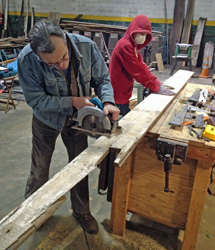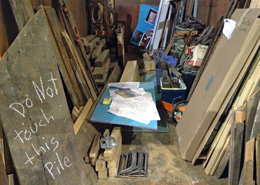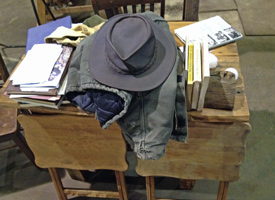Most Tuesday mornings down at the “Shed” on Torne Valley Road, across from the community recreation Torne Center, there can be heard a cacophony of students and sounds, the clang and clack of hammers, voices, whirring of electric saw. In the bustle of activity, tape measures get lost fast. The Shed is base camp for reconstruction of an old saltbox house that at one time stood in Ramapo Hamlet, the old work camp for the Ramapo Iron Works, located directly across the Ramapo River.
Founded by Jeremiah H. Pierson and brothers in 1795 or thereabouts on a 100 acre parcel of land bought from John Suffern, the old stone Ramapo Iron Works building stands today as the newly renovated Sentry Industries warehouse space on Rt. 17 at Bridge Street.
“We’ll use it as a little history museum and also as a lab,” said Chuck Stead about the saltbox house restoration. “It’s not just a museum to the iron works, it’s a museum to contamination, a museum to the impact and changes to the land in all of these 200 years.”
 Chuck Stead, environmental educator with Cornell University Cooperative Extension and Ramapo College, has slowly been bringing a plan of his to life — rebuild a piece of Ramapo history and use it as a showcase and working research lab for environmental studies.
Chuck Stead, environmental educator with Cornell University Cooperative Extension and Ramapo College, has slowly been bringing a plan of his to life — rebuild a piece of Ramapo history and use it as a showcase and working research lab for environmental studies.
“I have been working on studying the impact of the Ford Motor Company paint in the watershed,” said Stead as BOCES students from Pearl River High School worked on sanding down planks from the old house, preparing to cut them down to useable size. “It looked like Ford was not going to remediate, ever. So, I got the idea — it’s time to kick it up a notch. I went back to the town and said, look, you have the house in storage. I want to rebuild the salt box house as an environmental research center. The idea here is a salt box, which is an image of the first industrial impact in our watershed, will become a home for the recovery from twentieth century industrial impact in our water shed.”
 Stead has been working with Ramapo College undergrad interns and BOCES high school students as part of a job/skills program that incorporates the restoration, design, and construction of a the 19th century saltbox. When completed, the project will be home to the Ramapo Saltbox Environmental Research Center (ERC), a field research center that will examine the long-range impact of watershed paint sludge contamination, the result of Ford Motor Company’s dumping around Ramapo and the Torne Mountain watershed during the 1960’s and 70’s.
Stead has been working with Ramapo College undergrad interns and BOCES high school students as part of a job/skills program that incorporates the restoration, design, and construction of a the 19th century saltbox. When completed, the project will be home to the Ramapo Saltbox Environmental Research Center (ERC), a field research center that will examine the long-range impact of watershed paint sludge contamination, the result of Ford Motor Company’s dumping around Ramapo and the Torne Mountain watershed during the 1960’s and 70’s.
“We’ll rebuild the house,” Stead said, “But we’ll use it as a little history museum and also as a lab. So, it’s not just a museum to the iron works, it’s a museum to contamination, a museum to the impact and changes to the land in all of these 200 years.”
 A saltbox house is an old Colonial frame house with two stories in front and one in back, a style of architecture that originated in New England. Saltboxes have pitched roofs with unequal sides — short and high in front and long and low in back.
A saltbox house is an old Colonial frame house with two stories in front and one in back, a style of architecture that originated in New England. Saltboxes have pitched roofs with unequal sides — short and high in front and long and low in back.
Support and partial funding for the project comes directly from the Town of Ramapo’s Cultural Property Management department, headed up by Tom Sullivan. Part of the Open Spaces initiative by Supervisor Christopher St. Lawrence, the department oversees historical properties throughout Ramapo, including Harmony Hall in Sloatsburg, Henry Varnum Poor House (of Standard & Poor fame), the Smith Family Farm, and Mobray-Clarke House.
Stead said that although St. Lawrence has been consistently supportive of the whole ERC project, he supplements funds from the town with grants and lots of volunteer elbow grease. “Now, I don’t have  a ton of money to do this with,” he said. “It’s a lot of work to restore the old wood — that’s a big piece of it. Because I work for Cornell Cooperative Extension, I managed, through them, to write a grant to teach BOCES kids to do woodworking. So, it’s educational. I taught the kids how to make furniture joinery. Our furniture is made out of 200 year old wood. The whole idea is, we’re taking history and marrying it to environmental studies and recovery of the the watershed.”
a ton of money to do this with,” he said. “It’s a lot of work to restore the old wood — that’s a big piece of it. Because I work for Cornell Cooperative Extension, I managed, through them, to write a grant to teach BOCES kids to do woodworking. So, it’s educational. I taught the kids how to make furniture joinery. Our furniture is made out of 200 year old wood. The whole idea is, we’re taking history and marrying it to environmental studies and recovery of the the watershed.”
Joanne Scichilone, a teaching assistant with the Pearl River High School BOCES PAVE Program, said her class has been coming to the Shed once a week throughout the semester and the kids love the atmosphere. “This is an opportunity for them to learn practical skills, to work with tools, to work with wood as a collaborative team,” she said. “They’ve done everything from make drawings and layout plans to learning restoration skills. It’s a big deal, coming here and working on the future environmental center.”
Stead and students are repurposing boards and making furniture for the new saltbox house. The house won’t be an exact historical restoration. “We couldn’t just build it back directly, we had to pass inspection,” said Stead. “We can’t just have an old historic building. We have to build it to code, lay the slab, footing, platform. Configure a stick frame structure. After the structure is okayed, the salt box house gets wrapped in original material — all these timbers and boards around here. It will look pretty close to what it would have looked like, but with a lot of modifications.”
Stead said the project is essentially a Brownfield Action classroom, designed to expose students to real world problem-solving skills that allows them to gain practice tackling a large-scale, interdisciplinary science problem. The onsite field work teaches students the skills required to produce a professional level environmental site assessment.
“The Brownfield Action was designed to expose students to skills needed by environmental scientists in diagnosing sources of groundwater contamination,” he said. “So, we have our research study, if you go into the house you’ll see that there’s a loft upstairs where students from Ramapo College will continue doing soil and water research. No one has done the kind of research that I want to do — good primary research.”
This past summer, Ford representatives, along with reps from Arcardis, Ford’s longtime environemental remediation contractor, visited the saltbox while Stead and 15 Americorp students were hard at work framing. “When Ford showed up, they saw all these kids. They saw we didn’t go away.”
Ford is scheduled to begin a new remediation effort this coming fall in the OU1 area of the United Water well field, a five acre stretch near the saltbox house.
And Stead continues to expand the educational reach of the Ramapo project.
Starting this Friday, Stead will host a weekend retreat at the saltbox house for Antioch University students traveling here specifically to study the site and saltbox house restoration. A contingent of Ramapough Indians will meet with the Antioch students to help immerse them in the historical events entwined in the birth of American industry and environmental contamination that took place right here along the Ramapo River.


